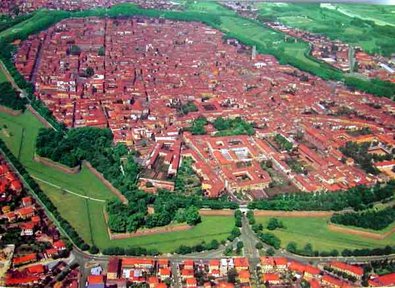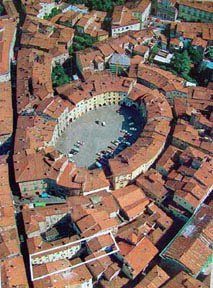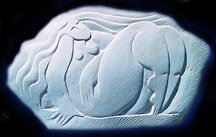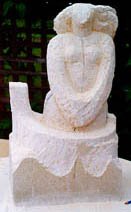|
See
more sculpture out of Oamaru stone here.
I started carving when I was still making
pots for a living. I'd carve designs in the clay surface which
would collect and pool the glazes to enhance the design. One
day I thought, what am I making pots for? Why not just carve?
In 1982, a friend introduced me to some
California soapstone and that was that. Love at first sight.
I carved using only hand tools for ten
years before I felt I was ready for the bite and speed of machine
tools. I wanted to learn the feel of the various types of stone,
learn how each one responds to various movement, tool, type of
cut; what stone was how hard, came in what colors, could be used
for figurative or simple design. I could probably have gone for
the rest of my life without using power tools, but being a pretty
impatient person and wanting to see reuslts faster, I finally
felt that I should make the shift.
So I went to Italy to learn from a master
how to use air tools - tools powered by air, rather than by electricity.
I had been using power grinders and polishing tools, but air
tools are so much easier. I learned how to carve marble there,
as well.
 |
Italy!
It was quite an experience.
I went with a group of folks that was escorted
by artist John del Monte.* We stayed in the historic famed walled
town of Lucca.
Once upon a time it was actually a capital
of Italy.
|
It also was a robber's town, and now has
the distinction of having more banks per capita there than any
other town. Go figure....
Most of us were experienced carvers, some
not, but within a short amount of time our Professore, Roberto
Bertola, had us whipped into shape and carving easily with air
tools as if we had done it all our lives.
 |
This is an arial shot of Lucca. The white
square shows the little street complex where most of his students
stay at Albergo La Luna.
I had the enormous good fortune to get
to the hotel and find my room taken, so they gave me a 3-bedroom
apartment nearby for the same price!
It was right near the campanile - the bells
at the church right across the street. They chimed almost
on the hour....
* You can see John's work and read about
the tours he manages at: westpennart.com/images/#ARTIST%20STATEMENT
|
I went to Italy again in 1992, staying
in the marble town of Pietra Santa - the town down the mountain
from Carrara, where Michaelangelo got his stone for the David,
among others. He stayed at the hotel right around the corner
from where I was staying.
It was so wonderful to go to the piazza
every morning to the bar* and look up to see the name Michaelangelo
on the building right there, knowing he had been there, carved
in this very town, walked these very streets!
This time I studied with another master,
Leo Muti. This time I was with one of stone carver Lynn Streeter's
groups. I'm not usually a group kinda gal, but this time it was
great to go with a group. You get studio space for lots less
than if you were alone, and feedback and ideas every day that
wouldn't ordinarily be there if you were solo. The hotel fees
are less, as well, with the group discount. Besides, it's just
more fun!
* In Italy, a bar is not an alcohol-serving
establishment. It is an eating place (from a tiny one-person
counter stuck in a niche in an outside wall to a large restaurant-sized
place) where you order at a bar, get the food, and then go sit
at an outside table, or if in a hurry, stand at the bar to eat.
Took me a while to get used to going to a "bar" for
my meals!
 |
Bas Relief: sculpture that, rather than being three dimensionsal
and standing on its own, is carved or cast so that it stands
out from a surrounding background.
This is Relax, carved out of NZ
Mt. Somers stone.
|
Carving in bas relief is one of my favorites
things to do. There's something about making a flat piece of
material look three dimensional that just gives me a kick!
 |
This is how I'm Happy to Be Me started
out.
After drawing the approximate locations
of the various design elements on the stone with a hard, fat,
red sculpture crayon, I used the grinder to cut that hunk out
of the left side there, then went at it with half-inch and quarter-inch
chisels.
Lopping off the long end of the hammer
allows me to have more wrist action without the end of the hammer
brushing against the inside of my wrist.
|
 |
Here it's about one-third through. The
elements have been shaped out, and now I can step back and see
if I want to make any major changes.
You can see how tall the prow is now -
whereas later I chopped it off - it just seemed too big for the
boat.
|
 |
Next step is to rough out the boat.
At this point, I hadn't even started the
water.
I wanted to make sure the figure was right
before I did anything else - then I could be assured that I wouldn't
have to go back and shorten her or move her around at all.
|
 |
Almost done. Usually I work a piece all
over to keep consistent style and movement. But this one seemed
to have its own logic. You can see how the figure is almost done,
and the water is only part way finished.
I left the water very coarse - movement
and action! - and used rifflers - no snadpaper - on the figure.
It's just short of softly finished. Peace and tranquility - just
cruisin' in my little boat!
|
You can see the finished piece here.
Now I'm back in Hawaii, and haven't carved
since I left NZ., but I'll start carving again!
Most of the stone sculptures on this site
are now unavailable, but f you see one on these pages that you
like and want to commission, I can create a piece for you that
is similar to what you see here, or is a starting point for something
different. Please make sure you read the information on commissions.
|